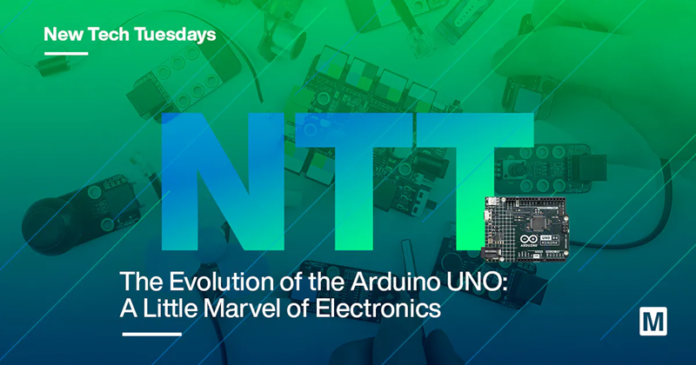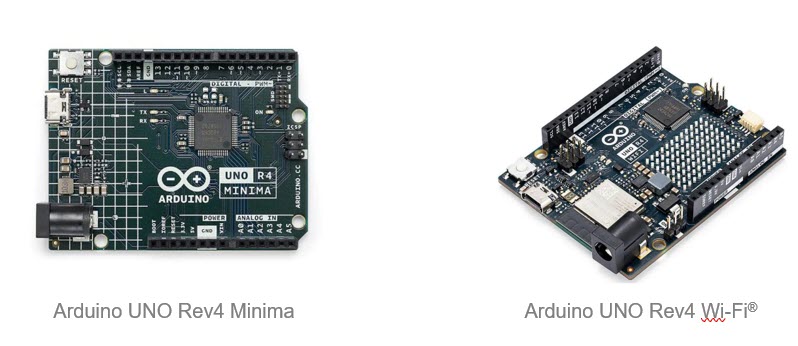
Join Rudy Ramos for a weekly look at all things interesting, new, and noteworthy for design engineers.
The Arduino UNO Board, a tiny microcontroller board that packs a punch, has captured the imaginations of hobbyists, educators, and even professionals since its inception. Over the years, it has undergone various iterations, becoming more refined, versatile, and user-friendly.
Born in the picturesque town of Ivrea, Italy, Arduino originated as an inexpensive tool for students. Massimo Banzi and his colleagues introduced the Arduino platform in 2005. It was developed as a simple, open-source electronics platform with a user-friendly software interface for creating digital devices and interactive objects. Arduino has become increasingly popular among hobbyists and professionals and is now used in a variety of applications, from robotics to home automation. Its open-source nature has enabled it to grow into a global community of makers and developers.
Functionality: The Heart and Soul of Arduino
At its core, the Arduino UNO Board is essentially a microcontroller on a circuit board. It interprets and executes written software codes, allowing communication with devices such as sensors, motors, and even other microcontrollers. Due to their simplicity and versatility, Arduino boards have found applications in countless projects, ranging from basic LED displays and complex robots to drones, weather stations, and game controllers.
One of the standout features of the Arduino movement is its commitment to open-source principles. By making hardware design and software libraries open and freely available, Arduino ignited a revolution. This openness fosters a robust community of enthusiasts, educators, and developers. As a result, countless projects, guides, and libraries are available online, making it easier for newcomers to learn and experiment.
Websites such as Maker Pro, Instructibles, Circuit Basics, Hackaday, ElectronicsHub, and YouTube are just a few of a multitude of websites brimming with resources for makers. These sites enable design collaboration, project showcasing, and knowledge sharing. They also offer a space for receiving valuable feedback from a passionate community of enthusiasts.
Impacting the Maker Community
The affordability and accessibility of the Arduino UNO Board spurred a ‘Do-It-Yourself’ (DIY) culture, particularly within the maker community. Makerspaces and tech workshops worldwide adopted Arduino for its ease of use, leading to a proliferation of prototypes and projects. From creating interactive art installations to building home automation systems, Arduino has become the backbone of countless innovative ideas.
Featured Product
June 2023 saw the latest Arduino UNO REV 4 Boards release in the form of two new flavors: the UNO R4 Minima and UNO R4 Wi-Fi (Figure 1). Both new boards mark a departure from the Microchip Technology ATmega4809 8-bit microcontroller used in the previous generation of the UNO. The two new boards now sport a Renesas RA4M1 32-bit 48MHz Arm Cortex-M4 microcontroller with a floating-point unit (FPU) and 256kB flash, 32kB SRAM, and 8kB data memory (EEPROM), bringing a considerable performance boost for numerous applications. Additionally, the R4 Wi-Fi incorporates an Espressif S3 Wi-Fi module for Wi-Fi and Bluetooth Low Energy connectivity, as well as a bright 12 x 8 red LED matrix, ideal for plotting sensor data without the need for additional display hardware. These new board versions are form factor, pin, and power compatible with the R1 through R3 versions, so they should largely be able to serve as drop-in replacements, which potentially makes them compatible with hundreds of existing third-party shields and other accessories.

Figure 1: Arduino UNO REV 4 Boards powered by the Renesas RA4M1 32-bit 48MHz Arm Cortex-M4 microcontroller. (Source: Mouser Electronics)
A Bewitching Time Approaches
Autumn’s embrace is truly a bewitching time, with the air turning crisp and the leaves painting the earth in hues of gold and crimson. In my corner of the world, the chilling embrace of winter starts to whisper, but not before the spine-tingling celebrations of Halloween take center stage.
As the shadow of Halloween 2023 looms closer, the Arduino UNO R4 Wi-Fi presents an intriguing new spectral delight for those looking to add a fear factor to their decorations. One can’t help but imagine the eerie and otherworldly creations that will come to life with this technology in hand. Will we see possessed pumpkins sending ghostly messages through the Wi-Fi waves? Or perhaps haunted houses that sync with the digital realm, giving those brave enough to enter an augmented reality fright? The possibilities are as endless as the night is dark.
With such advancements in our grasp, this Halloween promises to be an electrifying blend of traditional spookiness and cutting-edge innovation. So, to all tech witches and wizards out there, ready your cauldrons! The Arduino UNO R4 Wi-Fi awaits your darkest and most ingenious incantations.
One of my favorite ghostly Halloween creations comes from a YouTube maker who brewed a spooky concoction of technology and terror! Using the magic of an Arduino UNO, the piercing gaze of a few budget-friendly IR cameras, and the swift motion of a servo motor, this innovator brought their front yard Grim Reaper to life. Beware, trick-or-treaters! As you dare to walk past, the Reaper’s head eerily follows along with your every move, ensuring a hauntingly unforgettable All Hallows’ Eve experience.


















